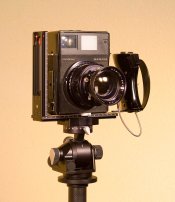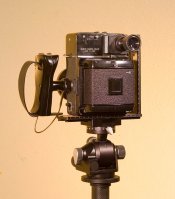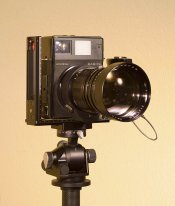Neil Poulsen
Member
- Joined
- May 28, 2005
- Messages
- 525
- Format
- 4x5 Format
Yes, I have a crush on the Mamiya Universal Press camera system. It’s an excellent system that can be used in multiple ways, and I thought it would be fun to describe this system in detail. I’ve reserved the first four posts for that purpose; I will add content over time.
The photos below show the camera from front and back. The first photo shows the front view with the 100mm f2.8 lens. This is a very sharp and fast lens. There's also a less expensive, slower f3.5 version. The second photo shows the camera from the rear. My camera has a "G" adapter attached that enables one use Graphlex type film holders. In this case, I'm using Mamiya RB67 film holders. On the upper right, I've attached a viewfinder extension accessory that more conveniently enables me to use these film holders. Unfortunately, these extenders are very rare. The "G" adapter will not accept Horseman nor Wista film holders. One can find diopter adjustment lens pieces for this camera that will work with and without the viewfinder extension. I hope to find a +1 for my somewhat near-sighted right eye.
Normally, one would use film holders that were specifically designed for the camera using an "M" adapter. These film holders are relatively thin, so it's unnecessary to use the viewfinder extension. Due to their design, they're also capable of holding film to be very flat. They come in 6x7 and 6x9 formats. There's also a version that can be used for both the 6x7 and 6x9 formats, as well as the 4.5x6 format. I will add a photo that shows the rear of the camera with one of these film holders attached.
As one might expect from the photos, this camera is ideal for photographing hand-held. This is a range finder camera, where one aligns the image in a small, central box to achieve accurate focus. A neat characteristic of a range-finder system, one can maintain watchfulness of the image at the instant of exposure. This isn't true for any SLR system. One can find instructions on the photo.net site for adjusting this range finder system. It's an easy enough adjustment that involves removing a couple of screws to remove the top part of the camera.
For tripod work, I have an Arca Swiss "L" bracket attached to the camera that allows me to position the camera in either landscape (shown) or portrait orientations.
The photos below show the camera from front and back. The first photo shows the front view with the 100mm f2.8 lens. This is a very sharp and fast lens. There's also a less expensive, slower f3.5 version. The second photo shows the camera from the rear. My camera has a "G" adapter attached that enables one use Graphlex type film holders. In this case, I'm using Mamiya RB67 film holders. On the upper right, I've attached a viewfinder extension accessory that more conveniently enables me to use these film holders. Unfortunately, these extenders are very rare. The "G" adapter will not accept Horseman nor Wista film holders. One can find diopter adjustment lens pieces for this camera that will work with and without the viewfinder extension. I hope to find a +1 for my somewhat near-sighted right eye.
Normally, one would use film holders that were specifically designed for the camera using an "M" adapter. These film holders are relatively thin, so it's unnecessary to use the viewfinder extension. Due to their design, they're also capable of holding film to be very flat. They come in 6x7 and 6x9 formats. There's also a version that can be used for both the 6x7 and 6x9 formats, as well as the 4.5x6 format. I will add a photo that shows the rear of the camera with one of these film holders attached.
As one might expect from the photos, this camera is ideal for photographing hand-held. This is a range finder camera, where one aligns the image in a small, central box to achieve accurate focus. A neat characteristic of a range-finder system, one can maintain watchfulness of the image at the instant of exposure. This isn't true for any SLR system. One can find instructions on the photo.net site for adjusting this range finder system. It's an easy enough adjustment that involves removing a couple of screws to remove the top part of the camera.
For tripod work, I have an Arca Swiss "L" bracket attached to the camera that allows me to position the camera in either landscape (shown) or portrait orientations.
Attachments
Last edited:










